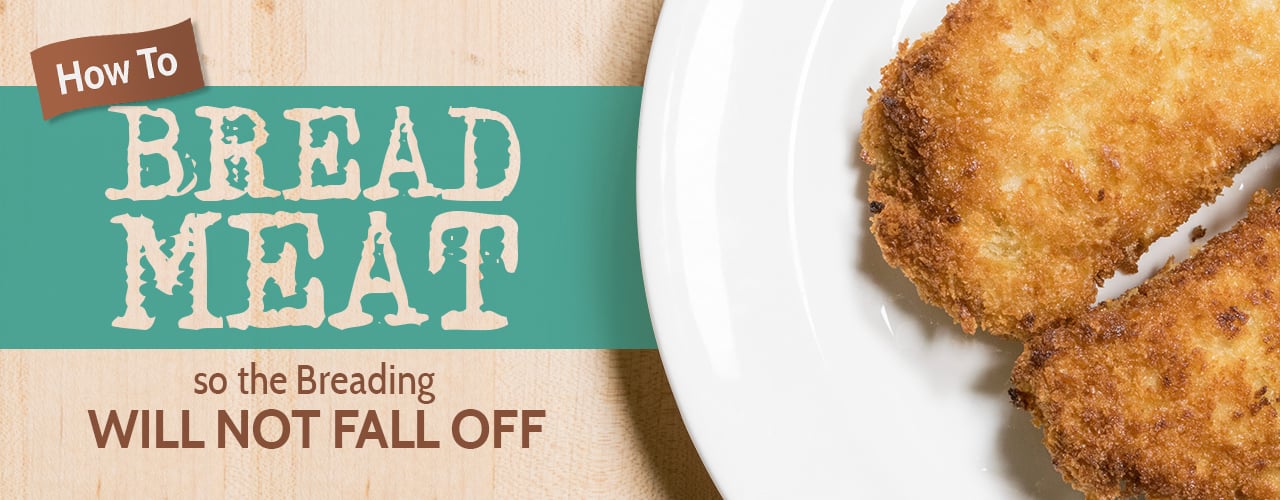How to Bread Meat so the Breading Won't Fall Off
Last updated on Oct 15, 2025Jessica WieserWhether you’re frying up chicken, pork, or steak, the crispy outer breading adds a satisfying crunch, attractive coloring, and delicious taste to your meal. However, sometimes that breading can begin to flake off while cutting into it, forcing your customers to eat the breading separate from the meat. In order to keep your delicious dishes whole throughout the entire meal, here are step-by-step instructions on how to bread meat so the breading won’t fall off. You can follow along with the video below.
Ingredients You'll Need
- Your Choice of Meat
- Milk or Buttermilk
- Flour
- Assorted Seasonings
- Breadcrumbs
- Egg Wash
Step by Step Instructions for Breading Meat
-
 1.
1.Season the meat with salt and pepper.
 2.
2.Soak the meat in buttermilk. You can also use milk or a seasoned milk mixture. Let it sit for at least a half hour.
-
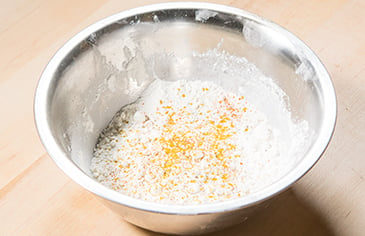 3.
3.Season your flour using spices like paprika, thyme, salt, mustard powder, parmesan cheese, or other ingredients of your choosing.
 4.
4.Remove the meat from the milk mixture and thoroughly coat it in the seasoned flour.
-
 5.
5.Place the meat on a tray, cover, and put it in the refrigerator for one hour. This is extremely important as it allows the flour to become sticky and attach to the meat.
 6.
6.Prepare the breading in a shallow dish.
-
 7.
7.First, coat the meat in egg wash. Then, thoroughly coat the meat with breading.
 8.
8.Gently lay the breaded meat in your pan. Be sure not to overcrowd.
-
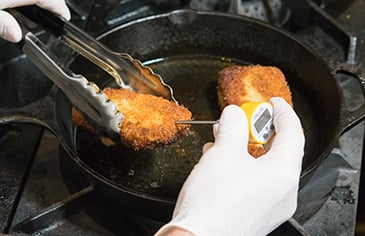 9.
9.Use your probe thermometer to keep track of the temperatures of the meat and oil. Turn your meat over when it's browned.
 10.
10.When your food is done cooking, remove it from the oil and set it on clean, dry paper towels to absorb the excess oil.
-
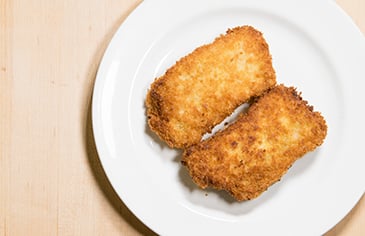 11.
11. Serve for your customers to enjoy!
When it comes to breading meat, most breading procedures are basically the same. But taking the extra time to soak your meat in buttermilk and let the flour set will ensure that your breading is fully adhered for the perfect breaded pork chops or breaded chicken. This creates a final result that is crispy on the outside, juicy in the middle, and altogether irresistible.
Related Resources

Best Oil to Fry Fish
Thanks to its neutral flavor, affordable price, and high smoke point, canola oil is the most popular oil for frying fish. Peanut, cottonseed, and coconut oil are also great fish frying oils. Keep reading to discover the benefits of each oil you can use to fry fish. We also offer fish frying tips, so you can cook your fish fillets to perfection every time. Shop All Fryer Oil Best Oil for Deep Frying Fish To help you select the best oil for your fish fry, discover the top oils for deep frying fish, their smoke points, and their benefits below: 1. Canola Oil Canola oil has a high smoke point and a neutral flavor. Rich in omega-3 and omega-6 fatty acids, canola oil is a comparatively healthful choice for frying fish. It is also relatively affordable. Canola Oil Smoke Point: 400 degrees Fahrenheit 2. Peanut Oil Peanut oil is affordable, and it has a neutral flavor that won't affect the flavor of your fish. It also prevents flavor transfer. Unfortunately, peanut oil contains one of the big 8 food allergens, which limits the number of guests who can enjoy your fried fish. Peanut Oil Smoke Point: 450 degrees Fahrenheit 3. Cottonseed Oil Cottonseed oil has a high smoke point. It's also affordable, making it an excellent option for establishments that are frying in bulk and need to stock up on oil. Cottonseed Oil Smoke Point: 450 degrees Fahrenheit 4. Coconut Oil Coconut oil is the healthiest option for deep frying your fish. It has a neutral taste and reduces flavor transfer between batches. However, coconut oil is a less economical choice. Coconut Oil Smoke Point: 450 degrees Fahrenheit Oil for Frying Fish The type of oil that you deep fry your fish in impacts how it fries, its taste, and its texture, so it's important that you choose the right oil for the task. Here are three major things you need to consider when choosing oil for frying fish: The Smoke Point - The smoke point is the temperature when oil starts to break down and become unusable. When deep frying fish, you want to use an oil that has a high smoke point so you can fry the fish at a high temperature. The Flavor - Fish is delicate, so you want to choose an oil with a neutral flavor that won't overpower the fish. Flavor Transfer - If you're frying different types of seafood (or other foods) simultaneously, you must prevent the flavors from transferring. Best Fish to Fry Not every type of fish is suitable for deep frying. When choosing a fish to deep fry, look for an option that has a neutral flavor and isn't too oily. Typically, neutral flavored, white-fleshed, and lean fish are best for frying. Freshwater fish such as bass, trout, and catfish are excellent choices. Avoid dense and oily tuna, salmon, and sea bass. Here are some of the best types of fish to fry: Tilapia Catfish Striped Bass Trout Cod Perch Shrimp Halibut Oysters Frying Fish FAQ Now that you know the best oil to deep fry fish with and which type of fish you should fry, you’re ready to prepare your own fish fry. Below, we answer some of the most frequently asked questions chefs encounter when frying fish. Oil Temp for Frying Fish Your fish frying oil temperature should range between 350 and 375 degrees Fahrenheit. The fish needs to reach a safe internal temperature of 140 to 145 degrees Fahrenheit before it is finished frying. How Long to Fry Fish As a general rule, you should deep fry small batches of fish for 3 to 6 minutes. You must adjust the time based on the type of fish you’re deep frying; you will need to fry your fish fillets longer than your oysters. How long you fry fish also depends on the temperature of your oil. How to Fry Fish with Flour and Egg Use our fried fish taco recipe to learn how to fry fish with flour and egg. It’s a simple process of creating a batter, dipping the fish into the batter, adding the fish to your fryer unit, frying it until it turns a beautiful, golden brown, and then cooling it on a parchment-lined rack. How to Make Egg Wash for Frying Fish Follow these simple steps to make an egg wash for frying 1 pound of fish: Crack 3 eggs into a bowl Add six tablespoons of whole milk Beat to combine the milk and eggs Deep Fried Fish Temperature Deep fry your fish at temperatures between 350 and 375 degrees Fahrenheit. If the temperature is above 380 degrees Fahrenheit, it will scorch the fish. If it's below 360 degrees Fahrenheit, the batter may absorb too much oil, creating a greasy mouthfeel. How to Prep Fish for Frying Prep fish for frying by following these simple steps: Brine the fish Create an egg wash Season the fish Dip the fish in the egg wash Dredge the fish in flour Flour or Egg First When Frying Fish? Coat fish in an egg wash first, then dredge it in flour. The egg wash will help the flour stick to the fish. Coating fish in egg and flour before frying it creates a crispy outer crust around the delicate, flakey protein. This flour shell also helps contain the protein’s juices and adds rich flavor. What to Soak Fish in before Frying Soaking fish in a 6 percent salt brine before frying it firms the fish, causing it to hold up better in the fryer. The salt in the brine enhances the flavor and keeps the meat from drying out. Selecting the right oil can ensure flavors don't transfer, the fish doesn't become greasy, and the seafood’s natural taste isn’t overpowered. Use our guide to analyze every factor that affects how your fish fries, including the best oils for frying fish, how to prepare fish for frying, and the best fish to fry.
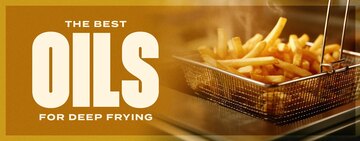
Choosing the Best Oil for Your Commercial Deep Fryer
When it comes to deep frying, choosing the right oil is crucial for kitchen safety and for creating delicious fried foods. Different cooking oils have a range of smoke points and flavors, making it important to consider these factors when selecting the best oil. Also, keep in mind that a commercial deep fryer holds several gallons of oil. Delicate oils that are expensive and break down quickly with heat will not be efficient or cost-effective for deep frying. Keep reading to learn more about the best oils for your deep fryer. Shop Cooking Oil Click below to learn about the best oils for commercial deep frying: How to Choose the Best Oil Recommended Oils Cooking Oils to Avoid Deep Fryer Oil FAQ What Is the Best Oil for Deep Frying? Vegetable oil and canola oil are two popular types of oil used for commercial deep frying because of their high smoke points. Which oil is the better option? Canola oil is often favored because of its neutral flavor, low saturated fat content, and balanced fatty acid profile. Vegetable oil, on the other hand, provides a more affordable and versatile option. It’s important to note that products labeled as “vegetable oil” are a blend of different plant oils and may contain canola, soybean, corn, or sunflower oil. Refer to the product label for the exact ingredients and the accurate smoke point. How to Choose the Right Oil for Your Deep Fryer When it comes to choosing an oil for your commercial deep fryer, there are several factors that you should consider. Each oil has its own set of characteristics, and understanding these factors will help you make an informed decision for your frying needs. Smoke Point: The smoke point of an oil refers to the temperature at which it starts to break down and produce smoke. Oils with higher smoke points are ideal for deep frying because they can withstand higher temperatures without burning. Some common oils with high smoke points include peanut oil, canola oil, and safflower oil. These oils are suitable for high-heat cooking and provide a crispy texture to fried foods. High Heat Stability: Deep frying requires heating the oil to high temperatures, so it is crucial to choose an oil that can withstand these heat levels without breaking down or oxidizing. Oils with high levels of monounsaturated fats, such as canola or peanut oil, are more heat stable and better suited for deep frying. Neutral Flavor: The choice of oil can greatly impact the flavor of your fried foods. While some oils have a neutral taste, others impart a distinct flavor to the food. For example, peanut oil adds a rich and nutty flavor, while olive oil provides a fruity and robust taste. It is essential to consider the flavor profile you desire for your dishes and choose an oil accordingly. Fat Content: Deep frying is often associated with unhealthy eating habits, but selecting the right oil can make a difference. Oils high in saturated fats, such as coconut oil or palm oil, are not the healthiest options for deep frying. Instead, opt for oils with healthier fat profiles, such as canola oil or sunflower oil, which are lower in saturated fats and higher in monounsaturated fats. Cost: The cost of oil can be a significant factor, especially for commercial establishments that use large quantities of oil for deep frying. Some oils, like peanut oil or avocado oil, can be more expensive compared to others. Consider your budget and the volume of deep frying you anticipate to determine the most cost-effective option. Allergies: It is essential to be mindful of potential allergens when selecting an oil for deep frying. Peanut oil is a popular choice due to its high smoke point and excellent flavor, but it can be problematic for individuals with peanut allergies. If allergies are a concern, consider using alternative oils like canola oil or soybean oil, which are generally safe for most individuals. Best Oils for Deep Frying We'll take a closer look at the best types of deep-frying oils and describe their benefits below: 1. Peanut Oil Peanut oil has a mild, nutty flavor that enhances the taste of fried foods without overpowering them. Not all peanut oils are considered an allergen, but it's recommended to avoid this product completely if you have a severe peanut allergy. Make sure to label your menu accordingly if you use peanut oil in your commercial kitchen. Flavor: Mild and nutty Smoke Point: 425 to 450 degrees Fahrenheit Cost: Slightly more expensive than some other oils 2. Canola Oil Canola oil is a neutral-tasting oil that allows the natural flavors of the food to shine through. It's also more affordable compared to other oils, making it a cost-effective option for commercial deep frying. Flavor: Neutral Smoke Point: 350 to 400 degrees Fahrenheit Cost: Affordable 3. Soybean Oil Soybean oil is one of the most economically priced oils available, making it a cost-effective option for commercial deep frying. Its wide availability also ensures that businesses can easily source it in large quantities, ensuring a steady supply for their frying needs. Flavor: Neutral Smoke Point: 400 to 450 degrees Fahrenheit Cost: Affordable 4. Sunflower Oil Sunflower oil's high smoke point ensures that it can withstand the heat without breaking down and compromising the quality of the food. This means that you can achieve crispy and golden results without the fear of the oil becoming rancid or imparting a burnt taste to your dishes. Flavor: Mild flavor Smoke Point: 440 to 450 degrees Fahrenheit Cost: Affordable 5. Cottonseed Oil Cottonseed oil is also a versatile option for commercial deep frying due to its ability to withstand repeated use. The oil's high smoke point and stability allow it to be reused multiple times without compromising the quality of the fried food or the oil itself. This can help to reduce overall costs and waste in a commercial kitchen. Flavor: Mild nutty flavor Smoke Point: 420 degrees Fahrenheit Cost: Generally affordable 6. Avocado Oil In terms of flavor, avocado oil has a mild and pleasant taste that does not overpower the food being fried. It's generally more expensive compared to other frying oils, but its numerous benefits can make it a worthwhile investment for the right commercial kitchen. Flavor: Mildly sweet and buttery Smoke Point: 520 degrees Fahrenheit Cost: More expensive compared to other deep frying oils 7. Blended Vegetable Oils Vegetable oil is one of the most convenient oils to use for deep frying because of its affordability and versatility. You will find that most vegetable oils are a blend of soybean, canola, corn, or sunflower oils. Flavor: Neutral Smoke Point: 400 to 450 degrees Fahrenheit Cost: Affordable Cooking Oils to Avoid When Deep Frying While some oils may be suitable for cooking methods like pan frying or sauteing, they may not be the best choice for deep frying in a commercial deep fryer. You'll need several gallons of oil to fill the tank on your deep fryer, so consider affordability. The oil also needs to remain stable at high temperatures and have a high smoke point. These are oils to avoid using in your deep fryer: Extra Virgin Olive Oil: One type of oil that is not recommended for deep frying in a commercial deep fryer is extra virgin olive oil. Although extra virgin olive oil is a popular choice for sauteing and dressing salads due to its rich flavor and health benefits, it has a low smoke point of around 320 degrees Fahrenheit. When heated beyond its smoke point, extra virgin olive oil can break down and release harmful compounds, resulting in a bitter taste. Coconut Oil: Although it has gained popularity in recent years, coconut oil may not be the best choice for deep frying in a commercial setting. While coconut oil has a high smoke point and imparts a subtle flavor to fried foods, it can be expensive compared to other oils commonly used in commercial kitchens. Butter or Margarine: While these fats may add a rich and flavorful taste to certain dishes, they have a low smoke point and tend to burn easily. This can result in a greasy and unpleasant taste, as well as potential fire hazards in a busy commercial kitchen. Flaxseed, Walnut, and Sesame Oil: These oils are not recommended for deep frying in a commercial deep fryer. They have distinct flavors that may not be suitable for all types of fried foods, and their low smoke points make them susceptible to burning at high temperatures. Instead, use these oils in applications where their flavors can shine through, like finishing dishes and dressing salads. Deep Fryer Oil FAQ We answer common questions about deep fryer oil below: What's the Best Oil for Deep Frying French Fries? Peanut oil is one of the most popular oils for deep frying french fries. Many cooks claim that it makes french fries extra crispy and gives them a nutty flavor. How Can I Extend the Life of My Fryer Oil? In a busy restaurant, one of the key factors in making your deep fryer oil last longer is proper maintenance and care. Regularly filtering the oil and removing any food particles or debris will help extend its lifespan. How Often Should I Change My Fryer Oil? In a busy restaurant, the frequency of changing fryer oil is crucial to maintaining the quality of your fried foods. On average, fryer oil should be changed once or twice a week. This can vary depending on factors like the type of food being fried, the temperature at which it is fried, and the frequency of deep frying. Regularly monitoring the oil's color, smell, and taste can also help determine when it needs to be changed. What Should I Do With Used Oil? To ensure proper grease disposal, it is important to follow the guidelines set by local health departments. One popular method is to work with a local recycling company that specializes in used cooking oil. They can provide regular pickups and ensure that the oil is properly recycled into biodiesel or other useful products. By implementing these practices, busy restaurants can effectively manage their deep fryer oil while also being environmentally conscious. Back to Top With so many cooking oils on the market, it can be tough to choose the right one for your deep fryer. If you are marketing a healthy menu, avocado oil might be a good choice for your business. For the most convenient and affordable options, tried-and-true cooking oils like vegetable and canola will produce consistent results and need to be replaced less often.

How to Deep Fry a Turkey
Deep frying a turkey is a delicious and flavorful way to prepare this classic holiday centerpiece. The process involves immersing a whole turkey in hot oil, resulting in a crispy, golden-brown skin and tender, juicy meat. While deep frying may seem intimidating, with the right equipment and precautions, it can be a safe and rewarding way to prepare a turkey. We'll walk you through the process of frying a whole turkey so you can add a new cooking method to your arsenal. Shop Outdoor Fryers Deep Fried Turkey Ready to get started? Check out our video to learn how to deep fry a turkey with a turkey fryer kit: <iframe scrolling="no" src="/v/?num=3679&width=600&height=500&embed=1" frameborder="0" height="500" width="600"></iframe> How Long Does it Take to Deep Fry a Turkey? Generally, it is recommended to deep fry a turkey for about 3 1/2 to 4 minutes per pound. So, for example, if you have a 15-pound turkey, it would take approximately 52 to 60 minutes to cook it through. However, it's important to note that this is just a rough estimate and you should always use a meat thermometer to ensure that the turkey is cooked to a safe internal temperature of 165°F. One of the main benefits of deep frying a turkey is the speed at which it cooks. Unlike traditional roasting methods that can take several hours, deep frying can produce a fully cooked turkey in just a fraction of the time. This is especially helpful when you have a large group of hungry guests eagerly awaiting their holiday feast. Check out these general cook times for deep frying a whole turkey: 10 pounds - 35 to 40 minutes 12 pounds - 42 to 48 minutes 14 pounds - 49 to 56 minutes 16 pounds - 56 to 64 minutes 18 pounds - 63 to 72 minutes 20 pounds - 70 to 80 minutes What Special Equipment Do I Need? Before you get started, you'll need to gather the following materials: Turkey, completely defrosted with giblets removed Frying oil Dry rub or marinade Turkey fryer, which should include a stock pot, rack, stand, propane tank, skewers, probe thermometer, and injector Paper towels Kitchen shears Oil thermometer Gloves, goggles, long-sleeved clothing Fire extinguisher Learn more about choosing the right oil in our turkey fryer oil resource. Deep Fried Turkey Recipe Follow our step-by-step instructions to deep fry a whole turkey. Make sure to read all safety recommendations included in your turkey fryer manual. Keep a fire extinguisher on hand in case of an emergency. 1.Set up the turkey fryer kit and turn on the burner, but keep the flame low. Fill the cooking pot with the correct amount of oil and place it on the burner. Now, turn up the flame to start heating the oil. 2.Attach an oil thermometer to the side of the pot and preheat the oil to 350 degrees Fahrenheit. Submerge the tip of the thermometer but don't let it touch the wall of the pot. 3.While the oil is preheating, start prepping the turkey. Pat down the fully defrosted bird with paper towels to remove any excess moisture. 4.Using kitchen shears, remove excess fat and cut slits in the front of each leg. 5.Using dry rub, marinade, or a combination of both, add seasonings to the turkey. You can also try injecting the turkey with marinade to lock in the flavor. 6.Place the turkey on the lifter and attach the hook. Remove the thermometer from the fryer before lowering the turkey into the pot. Re-attach the thermometer to the pot once the turkey is lowered in. 7.Put on safety gloves, apron, and goggles. Lower the turkey inch-by-inch into the pot, making sure to go very slowly. You should be going so slow that it will take about a minute to get the bird fully inserted into the oil. This will help to prevent boil-over or splashing. 8.Once the turkey is fully submerged, deep fry it for about 3 1/2 to 4 minutes per pound. 9.Slowly remove the turkey from the fryer, letting any extra oil drain from the cavity. 10.Check the temperature of the turkey using a probe thermometer. Its internal temperature should be at least 165 degrees Fahrenheit. When you’re finished, place the turkey in a pan or on paper towels. Just like you would rest a steak, rest the cooked turkey for 20-45 minutes to ensure it reabsorbs its juices. Check out our turkey carving tutorial to learn how to cut up your fried turkey the easiest way. Turkey Fryer Safety Tips Without the right preparation, deep frying a turkey does come with potential hazards. Follow our safety suggestions to help prevent fires, combustion, and oil spills. Completely Thaw the Turkey - If the turkey isn't completely thawed, the oil could boil over and start a fire. Always defrost the turkey using a food-safe method. Remove all giblets and drain the cavity before frying. If water or slush is left behind, the oil may bubble or splash when the turkey is placed in the pot. Don't Stuff the Turkey - Stuffing a turkey before cooking has the potential to cause cross-contamination. Set Up the Fryer in a Safe Place - Always make sure the fryer is on a flat surface that’s far from any flammable objects, such as wood decks, trees, and buildings. Check the Internal Temperature - The internal temperature of a fried turkey must be a minimum of 165 degrees Fahrenheit. Handle the Fryer Oil Safely - Adding too much oil to your fryer can lead to spillovers. Also, choose an oil with a high smoke point so that it doesn't overheat. Wear PPE - Wear protective clothing, including gloves, goggles, and long-sleeved shirts. Deep Frying a Turkey FAQ Below we go through some of the most common questions that arise when deep frying a turkey. How Long Does It Take to Deep Fry a Turkey? The general rule of thumb for deep frying a turkey is to cook it for 3 1/2 - 4 minutes per pound. How Long Do You Deep Fry a 20 lb. Turkey? Since turkeys should be deep fried for 3 1/2 - 4 minutes per pound, a 20 lb. turkey will take 70 to 80 minutes to cook all the way through. What Is the Right Temperature for Deep Frying a Turkey? For a deep fried turkey, the oil should be preheated to 350 degrees Fahrenheit, and the internal temperature of your turkey should reach at least 165 degrees Fahrenheit. Where Should You Check a Turkey's Temperature? The best place to check the temperature of a turkey is in the meatiest part of the thigh. This is one of the thickest parts of the turkey and also cooks slowly. If this portion of the thigh is at the right temperature, then the rest of the turkey will be as well. Deep frying a turkey offers several benefits that make it a popular cooking method. It's a quick process that results in a turkey that is incredibly moist and flavorful, with a crispy and golden brown skin. Deep frying allows for a versatile cooking experience, because you can experiment with different flavors and seasonings to create a unique and delicious turkey.
